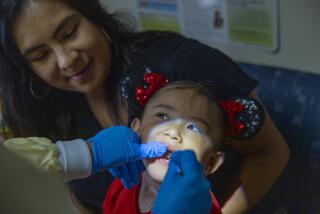Groups Press for Expanded Corrective Surgery Coverage
- Share via
“Losing Patience,” a July article, detailed a new trend by insurance companies to deny corrective surgery for infants and children with deformities.
The photos of Ross Greenwood, 7, were proof that such surgery can be of huge benefit.
Ross was born with Crouzon’s syndrome, a failure of the mid-face to develop. His parents’ request for surgery to correct his facial features was denied by their insurer because the surgery was considered “cosmetic” and “not medically necessary.” (They received approval only after Ross’ breathing became constricted.)
Within the past two years, more such rejections have cropped up. Many insurers balk over paying to correct misshapen heads, missing ears, maimed mouths and noses due to cleft lip and palate--even to remove infant facial tumors, which can grow to obscure much of the child’s face.
Insurers argue that there isn’t enough money to pay for everything and they must choose between procedures that save lives and those that make lives more livable.
The Times story led to a quick response.
Doctors and parents who had thought they were alone in their battles with insurance companies suddenly realized it was a widespread and escalating problem.
In California, Assemblywoman Liz Figueroa (D-Fremont), who chairs the state Assembly’s insurance committee, held a legislative hearing in October. “We had all the health insurance community there, along with the doctors and their patients. It became clear that even the doctors weren’t aware of how widespread the problem is, and of all the steps insurers are taking to deny this kind of reconstructive surgery,” Figueroa says.
As a result, Figueroa will introduce legislation in January “to make it mandatory for all health insurers to cover reconstructive surgery as defined by the American Medical Assn. They will no longer be able to claim that such surgery is cosmetic and therefore excluded,” Figueroa says.
The AMA defines reconstructive surgery as that performed on abnormal structures of the body, to make those structures look more normal. It defines cosmetic surgery as that which is performed to reshape normal structures.
“We think we will get bipartisan support,” Figueroa says. “A number of legislators have already called to say they are coming on as coauthors.”
Meanwhile, the American Society of Plastic and Reconstructive Surgeons sent a survey to all members to determine the scope of the problem nationwide.
“It turns out to be bigger than we thought,” says Dr. Henry Kawamoto, one of the reconstructive surgeons who appeared with his patients at Figueroa’s hearing. In an unusually speedy joint effort, a number of national groups banded together and presented a resolution to the AMA aimed at ensuring coverage of procedures associated with childhood deformities.
Resolution 119 was presented by the ASPRS and the American Society of Maxillofacial Surgeons, the American Assn. of Plastic Surgeons, the American Academy of Child and Adolescent Psychiatry, the American College of Surgeons, the American Pediatric Surgical Assn. and the American Society for Surgery of the Hand.
The resolution, approved Dec. 10, declares that treatment of a minor’s deformities should be covered by all insurers and calls for such coverage to include treatment that is medically necessary to provide a normal appearance for the child, even if it does not affect the function of the body part being treated.
Federal legislation may be next, says ASPRS Executive Director Dave Fellers.
For now, most insurers continue to do business as usual, Kawamoto says. “We have a baby who was scheduled for surgery six weeks ago. Her eyes are way too far apart. The insurance company refuses to authorize the surgery. The parents are desperately trying to raise some cash to pay for it themselves.”
More to Read
Sign up for Essential California
The most important California stories and recommendations in your inbox every morning.
You may occasionally receive promotional content from the Los Angeles Times.













